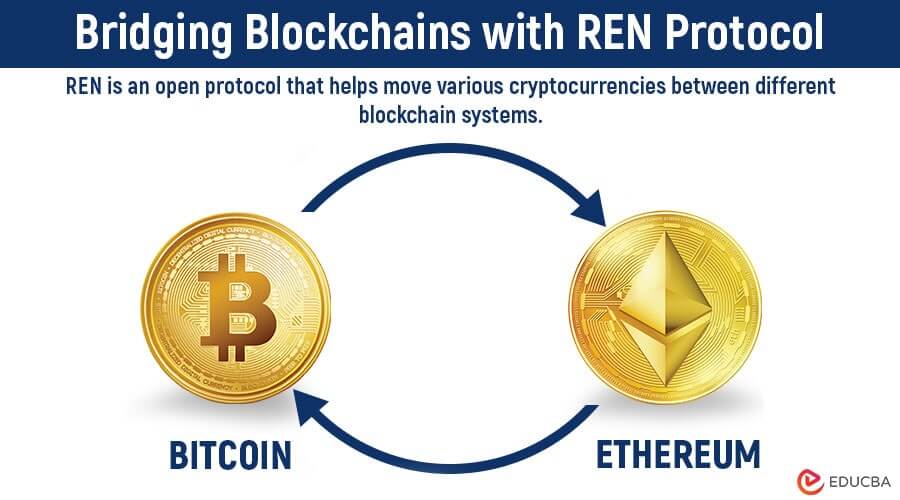
What Does Blockchain Bridging Mean?
Blockchain technology records transaction data securely and transparently through a decentralized system. However, different blockchain systems create independent networks known as “blockchain silos.” Generally, the assets of one blockchain network are restricted within that particular silos because there is no way to transfer them to another network. This is a major challenge as it limits the usage of decentralized applications (DApps). However, one way to improve this is through blockchain bridging.
Blockchain bridging refers to creating compatibility between two or more different blockchain networks to simplify the transfer of assets between them.
A great example of bridging blockchain is the Ren Protocol. It has emerged as a pivotal player in the blockchain ecosystem, providing a solution to bridge assets across disparate chains.
Navigating the world of cryptocurrency, as well as stock investments, requires informed decision-making. If you are considering investing, you must improve your understanding by learning from investing experts from esteemed firms like this education firm.
Table of Contents
- What Does Blockchain Bridging Mean?
- Why Do We Need to Transfer Assets Across Different Chains?
- Ren Protocol
- Role of Ren’s DarkNodes
- How Ren Protocol Works?
- Challenges and Future Developments
Why Do We Need to Transfer Assets Across Different Chains?
The decentralized finance (DeFi) sector has been remarkably expanding in recent years, showing how important it is to transfer assets (cross-chain assets) between blockchain transfers seamlessly. Since many DeFi platforms operate on different blockchains, we need a dependable mechanism or way to transfer assets effortlessly between these platforms.
The Ren Protocol emerges as a secure and decentralized solution to address this requirement. It is specifically designed for cross-chain transactions, offering users a strong medium to work with a diverse world of decentralized finance.
What is the Ren Protocol?
Ren is an open protocol developed by Ren Foundation that facilitates the easy movement of assets, especially cryptocurrency (inter-blockchain), between different blockchain networks. It simply acts as a bridge between different blockchains without needing any intermediates. For example, it will allow a user to convert one type of cryptocurrency to another (e.g., Bitcoin to Ethereum).
It makes interoperability easier with the help of Ren Virtual Machine (RenVM), a virtual machine that helps transfer assets across blockchains. This RenVM functions as a decentralized custodian, which holds assets securely. This innovative and trustless methodology of blockchain bridging guarantees the smooth movement of assets across various blockchains in a decentralized way.
Role of Ren’s DarkNodes
Ren’s DarkNodes operate Ren. They work similarly to Bitcoin miners or custodians, ensuring blockchain bridging and cross-chain transactions happen seamlessly. In other words, DarkNodes are special helpers in the network that run smart contracts and provide the proper computational resources (codes) needed to keep the network safe.
Furthermore, those individuals operating DarkNodes are rewarded with fees, thus building a decentralized and trustworthy ecosystem for moving assets between blockchains. This incentive-based model encourages active participation and ensures that the infrastructure supports the system for cross-chain transactions within the Ren network.
How Ren Protocol Works?
Let’s understand how the Ren Protocol works in blockchain bridging.
Suppose a user wants to transfer a cryptocurrency (asset), such as Bitcoin, from its native blockchain to another, like Ethereum. RenVM will convert Bitcoin into renBTC (a representation of Bitcoin in Ren) in the Ren Protocol. This renBTC will be equivalent to the amount of Bitcoin the user wants to transfer. The Ren Protocol will then transfer this renBTC to Ethereum without any involvement from third parties.
Thus, Bitcoin will have the same value in the Ethereum network. Moreover, the role of the Darknodes is to validate and verify the transactions initiated by users. They ensure that the assets from the native blockchain are successfully minted on the destination blockchain securely and transparently.
Challenges and Future Developments
Ren’s protocol extends beyond DeFi, finding applications in various sectors of the blockchain ecosystem. Prominent projects use Ren’s technology to enable cross-chain liquidity, allowing users to access a broader range of assets and opportunities.
Moreover, industries such as non-fungible tokens (NFTs) are exploring the potential of Ren’s protocol to enhance interoperability and foster collaboration between different blockchain ecosystems. Despite its strengths, the protocol faces challenges and risks that need continuous attention, such as maintaining the security and decentralization of the network.
Therefore, as the blockchain community actively engages with the Ren Protocol, there is a chance for future developments and refinements that will further enhance the protocol’s effectiveness. It will contribute to the continuous evolution of blockchain bridging and cross-chain interoperability solutions.
Final Thoughts
Ren Protocol offers a better platform for blockchain bridging. It facilitates the seamless transfer of assets across different blockchain networks. However, as the decentralization process rises, protocols like Ren will be crucial in achieving cross-chain interoperability within the blockchain space.
Recommended Articles
We hope this article on “Blockchain Bridging” was informative and helpful. To learn more, refer to the articles below.
